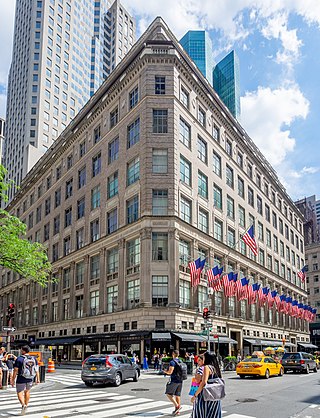
Saks Fifth Avenue is an American luxury department store chain headquartered in New York City and founded by Andrew Saks. The original store opened in the F Street shopping district of Washington, D.C. in 1867. Saks expanded into Manhattan with its Herald Square store in 1902 and flagship store on Fifth Avenue in 1924. The chain was acquired by Tennessee-based Proffitt's, Inc. in 1998, and Saks, Inc. was acquired by the Canadian-based Hudson's Bay Company (HBC) in 2013.
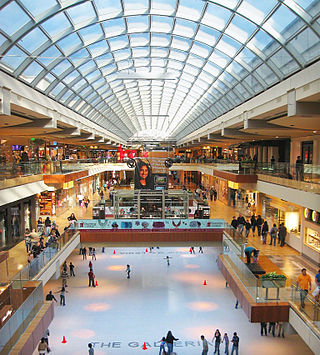
The Galleria, stylized theGalleria and also known as the Houston Galleria, is an upscale mixed-use urban development and shopping mall located in the Uptown District of Houston, Texas, United States. The development consists of a retail complex, as well as the Galleria Office Towers complex, two Westin hotels, and a private health club. The office towers and hotels are separately owned and managed from the mall. The mall features Macy's, Nordstrom, Neiman Marcus, and Saks Fifth Avenue.
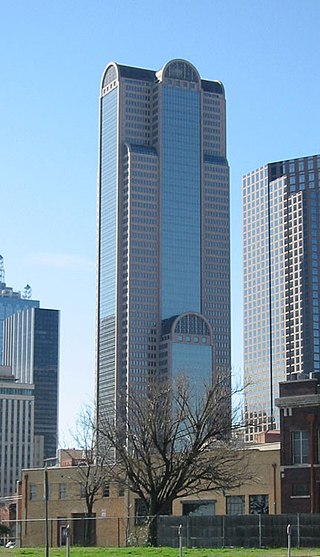
Comerica Bank Tower is a 60-story postmodern skyscraper located at 1717 Main Street in the Main Street District in downtown Dallas, Texas. Standing at a structural height of 787 feet (240 m), it is the third tallest skyscraper in the city of Dallas. It is also the sixth tallest building in Texas and the 61st tallest building in the United States. The building was designed by Philip Johnson and John Burgee, and was completed in 1987. The structure has 1,500,000 square feet (100,000 m2) of office space.
Marshall Field & Company was an upscale department store in Chicago, Illinois. Founded in the 19th century, it grew to become a large chain before Macy's, Inc acquired it in 2005. Its eponymous founder, Marshall Field, was a pioneering retail magnate.
Foley's was a regional chain of department stores owned by Federated Department Stores, later owned by May Department Stores (1988–2005) and headquartered in Downtown Houston, Texas. On August 30, 2005, the division was dissolved and operation of the stores was assumed by Federated's Macy's West and Macy's South divisions. Foley's operated stores in Arizona, New Mexico, Colorado, Oklahoma, Texas and Louisiana. On September 9, 2006 Foley's and all the regional May Co. stores names were phased out and rebranded as Macy's.

Rich's was a department store retail chain, headquartered in Atlanta, Georgia, which operated in the southern U.S. from 1867 until March 6, 2005 when the nameplate was eliminated and replaced by Macy's. Many of the former Rich's stores today form the core of Macy's Central, an Atlanta-based division of Macy's, Inc., which formerly operated as Federated Department Stores, Inc.
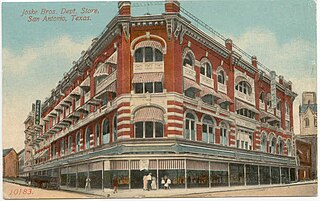
Joske's, founded by German immigrant Julius Joske in 1867, was a department store chain originally based in San Antonio, Texas. In December 1928, Hahn Department Stores acquired the company along with the Titche-Goettinger department store of Dallas, and three years later Hahn became part of Allied Stores. Allied was taken over by Campeau in 1986, and Campeau in turn sold the Joske's chain in 1987 to Dillard's. All Joske's stores were then quickly converted into Dillard's locations.
The Broadway was a mid-level department store chain headquartered in Los Angeles, California. Founded in 1896 by English-born Arthur Letts Sr., and named after what was once the city's main shopping street, the Broadway became a dominant retailer in Southern California and the Southwest. Its fortunes eventually declined, and Federated Department Stores bought the chain in 1995. In 1996, Broadway stores were either closed or converted into Macy's and Bloomingdales.

The Frost Bank Tower is a skyscraper in Austin, Texas, United States. Standing 515 feet (157 m) tall with 33 floors, it is the fifth tallest building in Austin, behind The Independent, The Austonian, Fairmont Austin, and the 360 Condominiums. It was developed by Cousins Properties from November 2001 to December 2003 as a class A office building with 525,000 sq ft (48,774 m2) of leasable space. It was the first high-rise building to be constructed in the United States after the 9/11 attacks. The building was officially dedicated in January 2004.
The William H. Block Company was a department store chain in Indianapolis and other cities in Indiana. It was founded in 1874 by Herman Wilhelm Bloch, an immigrant from Austria-Hungary who had Americanized his name to William H. Block. The main store was located at 9 East Washington Street in Indianapolis in 1896. The company also identified itself as The Wm. H. Block Co., and Block's.

May Company California was an American chain of department stores operating in Southern California and Nevada, with headquarters in North Hollywood, California. It was a subsidiary of May Department Stores and merged with May's other Southern California subsidiary, J. W. Robinson's, in 1993 to form Robinsons-May.

3 Bealls Holding Corp. was a Texan chain of department stores, owned by Stage Stores Inc. and headquartered in Houston, Texas. The store specialized in retailing desirable brand name apparel, accessories, cosmetics, footwear, and housewares.
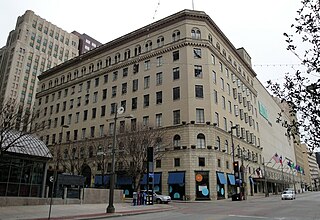
The Titche–Goettinger Building is one of Dallas' original broad-front department stores located along St. Paul Street between Main and Elm Street in downtown Dallas, Texas (USA). The structure currently houses apartments, retail space, and the Universities Center at Dallas. It is listed on the National Register of Historic Places both individually and as a contributing property in the Dallas Downtown Historic District and is a Dallas Landmark as part of the Harwood Street Historic District. It is also located across the street from Main Street Garden Park.

Sakowitz was a men's clothing store which grew into a small chain of family-owned high-end department stores based in Houston, Texas. It operated from 1902 until 1990. Sakowitz was responsible for launching many of the now-famous European fashion designers in America - among them Andre' Courreges, Yves St. Laurent Rive Gauche, Zandra Rhoades, Givenchy, and Erminegildo Zegna. The Sakowitz catalogues were mailed to all fifty states and abroad.
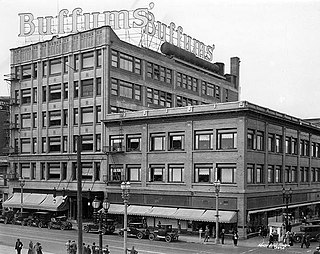
Buffums, originally written as Buffums' with an apostrophe, was a chain of upscale department stores, headquartered in Long Beach, California. The Buffums chain began in 1904, when two brothers from Illinois, Charles A. and Edwin E. Buffum, together with other partners, bought the Schilling Bros., the largest dry goods store in Long Beach, and renamed it The Mercantile Co. The store grew to a large downtown department store, and starting in the 1950s, grew slowly over the years to be a small regional chain of 16 speciality department stores across Southern California at the time of its closure in 1990.
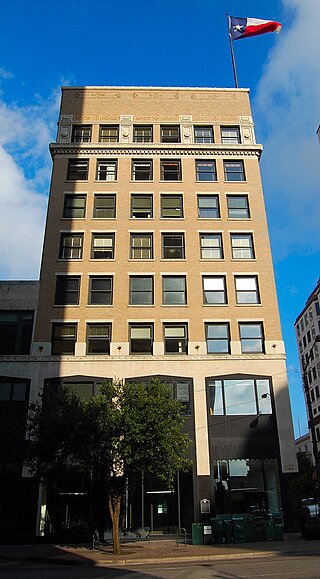
The Scarbrough Building is a historic commercial building in downtown Austin, Texas. Located on the corner of Congress Avenue and Sixth Street, the Chicago-style building was originally home to the flagship E.M. Scarbrough & Sons department store, simply known as Scarbrough's by locals. The building was the first steel-framed high-rise in Austin. In 1931, a renovation introduced Art Deco elements to the building; the renovation also made Scarbrough's the first retailer to have air conditioning west of the Mississippi River. The building was named a Recorded Texas Historic Landmark in 2001.

The Stowers Building is located at 820 Fannin Street in downtown Houston. The building was constructed in 1913 and is listed on the National Register of Historic Places (NRHP). The building is named for George Arthur Stowers and his furniture company, which had moved into the new "skyscraper" after a fire at his Main Street store. The local firm of Green & Finger designed the ten-story building which was constructed out of reinforced steel by Pearson & Co. The building was representative of a period of skyscraper construction in Houston between 1908 and 1913. It is listed on the National Register of Historic Places.

Retail in Southern California dates back to its first dry goods store that Jonathan Temple opened in 1827 on Calle Principal, when Los Angeles was still a Mexican village. After the American conquest, as the pueblo grew into a small town surpassing 4,000 population in 1860, dry goods stores continued to open, including the forerunners of what would be local chains. Larger retailers moved progressively further south to the 1880s-1890s Central Business District, which was later razed to become the Civic Center. Starting in the mid-1890s, major stores moved ever southward, first onto Broadway around 3rd, then starting in 1905 to Broadway between 4th and 9th, then starting in 1915 westward onto West Seventh Street up to Figueroa. For half a century Broadway and Seventh streets together formed one of America's largest and busiest downtown shopping districts.
The Kirby Lofts is an 11-story building at 917 Main Street in Downtown Houston, Texas, currently consisting of apartments with retail on the ground floor, originally built in 1926 and designed by Alfred C. Finn, a noted Houston-based architect.





















